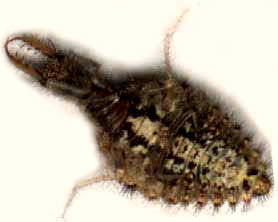 English Name: Antlion
English Name: AntlionFamily: Myrmeleontidae (Antlions)
Genus: ?
Species: ?
 English Name: Antlion
English Name: Antlion
Family: Myrmeleontidae (Antlions)
Genus: ?
Species: ?
The amazing creature you see at the right is an antlion larva, which in real life is only about ¼-inch long (7 mm). You've probably not seen anything like this because in the real world antlion larvae spend their time buried beneath the dust or sand. Well, there's a good story here...
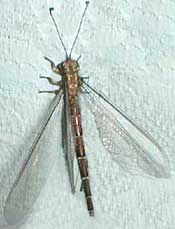 Adult antlions slightly resemble damselflies, as the picture at the left shows. The most obvious difference between them is that antlion adults bear long antenna with knobs at their tips. Adult anlions bear four veiny wings of equal length, are weak fliers, and we seldom notice them.
Adult antlions slightly resemble damselflies, as the picture at the left shows. The most obvious difference between them is that antlion adults bear long antenna with knobs at their tips. Adult anlions bear four veiny wings of equal length, are weak fliers, and we seldom notice them.
On the other hand, anyone living where it's warm and dry may have seen pits dug in sand or dust like the ones shown below. Those pits are about an inch across at the top (2.5 cm). In much of North America such pits can be found in the dust beneath trailers, inside dirt-floored sheds and barns, etc. Sometimes dozens or even hundreds such pits occur together.
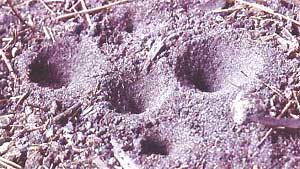
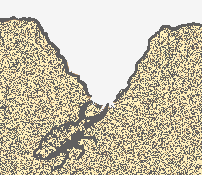 The drawing at the right shows the pits' secret: At the bottom of every pit there's an antlion larva waiting with its sicklelike jaws spread, ready for prey such as a wandering ant to tumble into the pit! When that happens, in a flash the antlion larva clamps its sicklelike jaws around its prey, gradually pulls the ant below the sand with it, and then sucks the ant's body dry...
The drawing at the right shows the pits' secret: At the bottom of every pit there's an antlion larva waiting with its sicklelike jaws spread, ready for prey such as a wandering ant to tumble into the pit! When that happens, in a flash the antlion larva clamps its sicklelike jaws around its prey, gradually pulls the ant below the sand with it, and then sucks the ant's body dry...
In the US Southeast, antlions are known by most folks as doodlebugs.
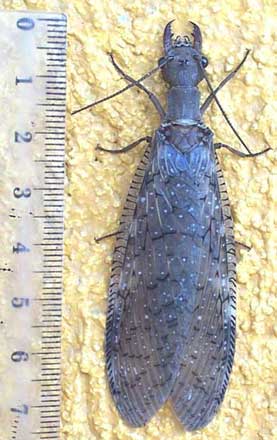 English Name: Dobsonfly
English Name: Dobsonfly
Family: Corydalidae (Dobsonflies)
Genus: Corydalus
Species: cf. leteus
The dobsonfly at the right is a female. I know that because males have much, much longer "pinchers," or mandibles. I found this particular critter on a stucco wall in northern Mexico. Apparently she had been attracted there during the night by the light bulb just above her, which had been burning. Usually dobsonflies are nocturnal, secretive, and seldom seen. Of the ±200 species of this genus, Corydalus, several extend into North America.
The ruler in the picture measures centimeters. It shows a length of about 7.4 cms, which is 2.9 inches -- a sizable critter! The female can inflict an unpleasant bite, but the male's much longer mandibles are used for holding the female when they are copulating, and aren't much good for anything else.
The dobsonfly's immature larval stage is aquatic, living 3-5 years in non-polluted, fast-running, well oxygenated rivers before metamorphosing. It's thought that the adults don't even eat, though they make drink a bit.
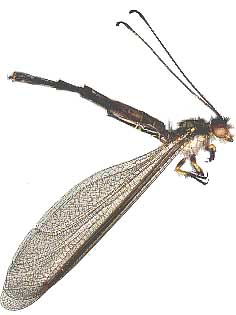 English Name: Owlfly
English Name: Owlfly
Family: Ascalaphidae (Owlflies)
Genus: ?
Species: ?
Owflies look a bit like dragonflies and adult antlions, except that their antennae are nearly as long as their bodies. Notice that, like the above antlion, its antennae are also clubbed. This shows just how closely related owlflies and antlions are.
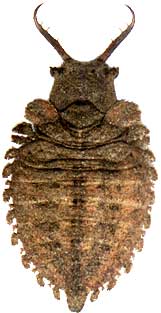 In fact, owlfy larvae look a lot like antlion larvae, as the image at the left shows. The most obvious physical
difference between them is that owlfly larvae are larger. The one at the left, from rear-end to pincer tip is 15/16ths of an inch long (24 mm) -- about three times the size of the antlion larva at the top of the page. Another big difference is behavioral. Owlfly larvae do not dig pits. They simply hang around on the ground's surface, often covered with dirt or debris, waiting for their prey to wander along. I found the one at the left clinging to a piece of wood, dead, apparently having drowned during a recent rainstorm.
In fact, owlfy larvae look a lot like antlion larvae, as the image at the left shows. The most obvious physical
difference between them is that owlfly larvae are larger. The one at the left, from rear-end to pincer tip is 15/16ths of an inch long (24 mm) -- about three times the size of the antlion larva at the top of the page. Another big difference is behavioral. Owlfly larvae do not dig pits. They simply hang around on the ground's surface, often covered with dirt or debris, waiting for their prey to wander along. I found the one at the left clinging to a piece of wood, dead, apparently having drowned during a recent rainstorm.
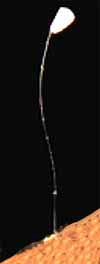 English Name: Lacewing egg
English Name: Lacewing egg
Family: Chrysopidae (Green Lacewings)
Genus: ?
Species: ?
You may be more likely to identify lacewing eggs, such as the one at the right, than a lacewing itself. Lacewings are very common, found in grass, weeds and shrubs, usually in relatively open area. The larvae look a lot like the antlion and owlfly larvae shown above, but with somewhat less spectacular pincers. The adults are similar to antlion and owlfly adults, but with somewhat more slender bodies and antennae. I'll feature one here when I find one. The egg at the right is on a stalk ¼-inch high (7 mm), so this is quite small, and you must look closely to find them. Often you notice them on the edges of weed leaves. The eggs are placed on stalks because when they hatch the larvae are so aggressively predaceous that if they could easily get at one another they might eat one another! Both adults and larvae feed principally on aphids, and thus should be welcomed by gardeners.
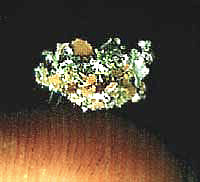 English Name: Brown Lacewing larva
English Name: Brown Lacewing larva
Family: Hemerobiidae (Brown Lacewings)
Genus: ?
Species: ?
At the right, that's a tiny Brown Lacewing larva on the tip of my finger. The crumbly stuff you see consists of tiny flakes of lichen. In other words, this species camouflages itself by sticking material such as lichen and even the exoskeletons of its dead prey to its own body! Because of this, Brown Lacewing larvae are often called Trash Bugs. In the picture, at the bottom left of the flaky mass, you can barely see legs extending down to my fingertip. As with the above Green Lacewing larvae, Brown Lacewing larvae are predaceous. In fact, the one in the picture came to my attention when I was reading beneath a tree and something started biting my naked back. I reached back and removed this Trash Bug, which seemed more than happy to eat me.